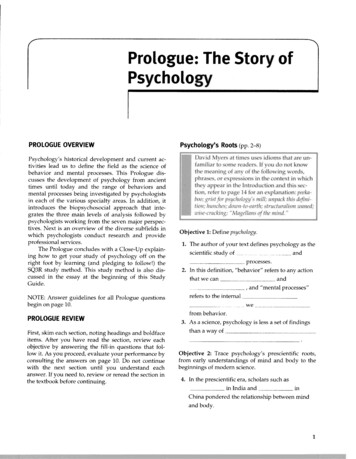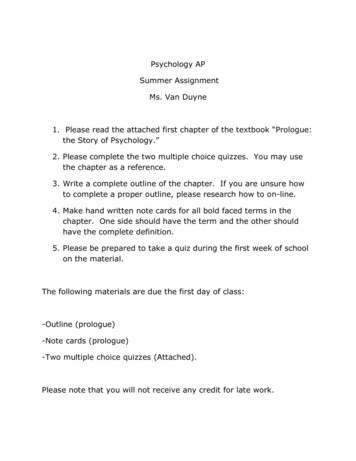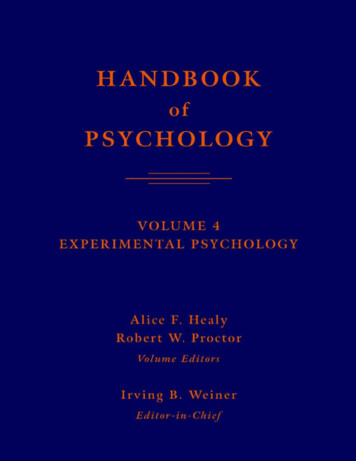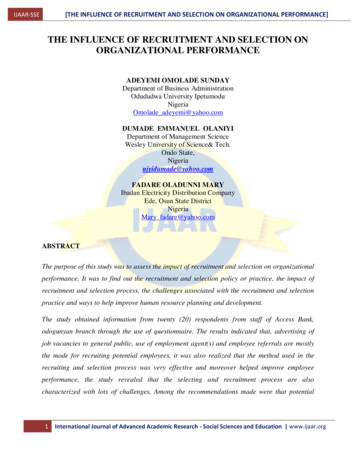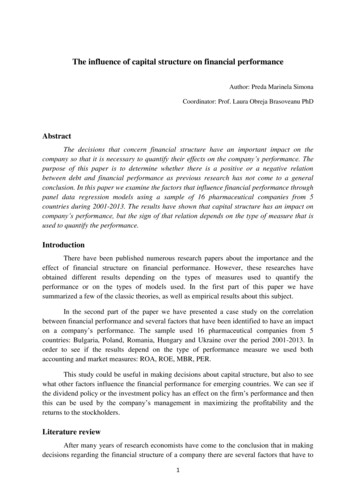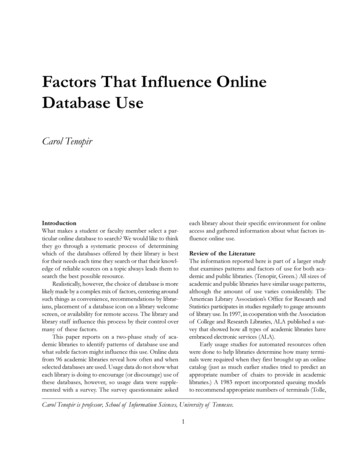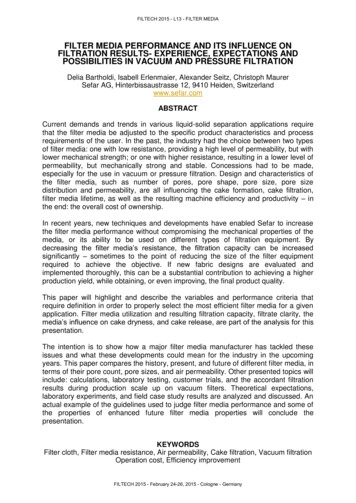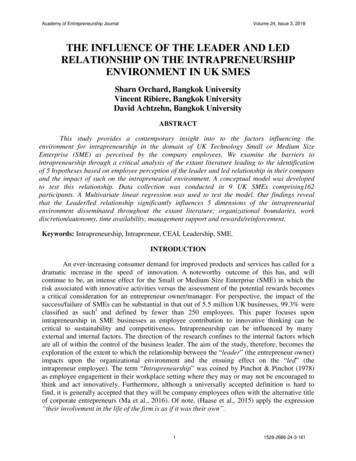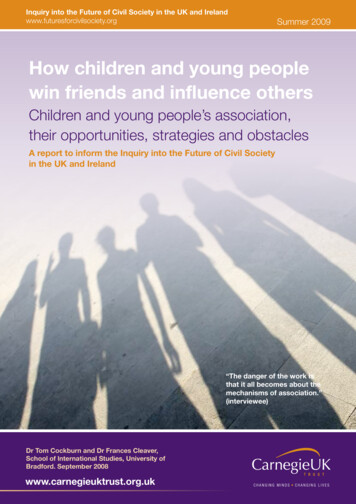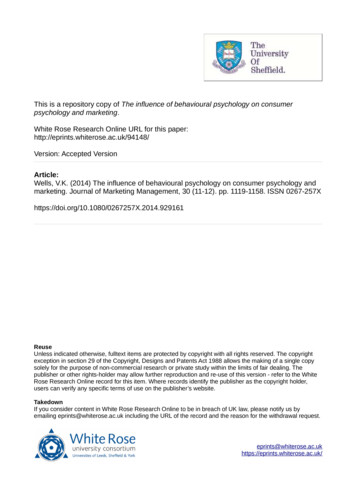
Transcription
This is a repository copy of The influence of behavioural psychology on consumerpsychology and marketing.White Rose Research Online URL for this : Accepted VersionArticle:Wells, V.K. (2014) The influence of behavioural psychology on consumer psychology andmarketing. Journal of Marketing Management, 30 (11-12). pp. 1119-1158. ISSN 161ReuseUnless indicated otherwise, fulltext items are protected by copyright with all rights reserved. The copyrightexception in section 29 of the Copyright, Designs and Patents Act 1988 allows the making of a single copysolely for the purpose of non-commercial research or private study within the limits of fair dealing. Thepublisher or other rights-holder may allow further reproduction and re-use of this version - refer to the WhiteRose Research Online record for this item. Where records identify the publisher as the copyright holder,users can verify any specific terms of use on the publisher’s website.TakedownIf you consider content in White Rose Research Online to be in breach of UK law, please notify us byemailing eprints@whiterose.ac.uk including the URL of the record and the reason for the withdrawal terose.ac.uk/
Behavioural psychology, marketing and consumer behaviour: A literature review andfuture research agendaVictoria K. WellsDurham University Business School, Durham University, UKContact Details: Dr Victoria Wells, Senior Lecturer in Marketing, Durham UniversityBusiness School, Wolfson Building, Queens Campus, University Boulevard, Thornaby,Stockton on Tees, TS17 6BH t: 44 (0) 191 3345099, e: v.k.wells@durham.ac.ukBiography: Victoria Wells is Senior Lecturer in Marketing at Durham University BusinessSchool and Mid-Career Fellow at the Durham Energy Institute (DEI). Her research interestslie in the application of behavioural psychology to consumer choice, foraging ecology modelsof consumer behaviour, and environmental behaviour, psychology and social marketing. Shejoined Durham University Business School in 2011 after holding the post of ResearchAssociate and Lecturer in Marketing and Strategy at Cardiff Business School. Before joiningCardiff Business School, she worked in Marketing Communications as an AccountExecutive. She has published in a wide range of journals, including Journal of BusinessResearch, Journal of Marketing Management, Marketing Theory, Service Industries Journaland Psychology & Marketing, amongst others, and is editor of the Handbook ofDevelopments in Consumer Behaviour published in 2012.1
Behavioural psychology, marketing and consumer behaviour: A literature review andfuture research agendaAbstract Psychology, along with a wide range of other academic disciplines, has influencedresearch in both consumer behaviour and marketing. However, the influence of one area ofpsychology—namely, behaviourism—on research on consumers and marketing has been lessprominent. Behaviourism has influenced consumer and marketing research through theapplication of classical and operant conditioning, matching, and foraging theories, amongstother frameworks, during the past 50 years. This article provides a review of research andapplications of behavioural psychology in the area, as well as a brief introduction ofbehavioural psychology for scholars unfamiliar with the area. The article also suggestsavenues for further research examining the potential development of behavioural psychologyapproaches for both consumer and marketing researchers.Summary statement of contribution Although prior research has reviewed specific areas ofbehavioural psychology influences on consumer behaviour and marketing research(Pornpitakpan, 2012) and others have provided an overview of all areas (classical and operantconditioning, foraging, consumer behaviour analysis etc) (DiClemente & Hantula, 2003a),the current research is the most detailed, up-to-date review of the area that both combines areview of operant and classical conditioning, matching, and foraging theories and provides acomprehensive future research conditioning; consumer behaviour analysis; foraging2operantconditioning;classical
IntroductionThe aims of this article are threefold. First, it strives to provide an overview of the state ofbehavioural psychology approaches and their applications to marketing and consumerbehaviour research. Although prior work has reviewed some aspects of behaviouralpsychology research and introduced or discussed behaviourism in the area of marketing andconsumer behaviour (e.g. DiClemente & Hantula, 2003a; Pornpitakpan, 2012), little, if any,research has combined these in an overall review in marketing management literature.Second, this article aims to provide an introduction to behaviourist thought for scholarsunfamiliar with behaviourism, including an understanding of how it developed as anindependent field and how its influence in marketing and consumer psychology began andhas continued to the present day. Third, the article suggests several avenues for furtherresearch examining the potential development of behavioural psychology approaches for bothconsumer and marketing researchers.Behaviourism developed in the early 20 th century as an approach to psychology thatargued that the only appropriate subject matter for scientific psychological investigation wasobservable, measureable behaviour (Foxall, 1987) and that behaviour was a function of itsconsequences and environment (Rothschild & Gaidis, 1981). Significant avenues ofbehaviourist thought have developed throughout history, though such thought is generallyattributed to the American psychologist John B. Watson, who is credited with fathering thediscipline (Bales, 2009). Watson’s approach was ‘antimentalist to the extreme’, ‘embodied astrict environmentalism’, and relied on ‘only that which is publicly verifiable in attempts totheorise about, explain and predict behaviour’ (Reber, Allen, & Reber, 2009). Watson madegreat strides in academia and had a renowned national reputation (Kreshel, 1990), but it isperhaps his approach to advertising that is most widely remembered. Watson’s advertisingcareer began in 1920, when he joined the J. Walter Thompson Company, after being3
dismissed from academia, and was able to apply his work in behaviourist theory in an entirelynew way, though it is widely debated how much he applied his theories beyond his role as‘ambassador-at-large’ for the company (Bales, 2009; Buckley, 1982; Kreshel, 1990).Along with Watson, other notable behavioural academics include Ivan Pavlov, whostudied conditioned responses through experimentation and is best known for his studies on aparticular form of behaviourism called ‘classical conditioning’, and B. F. Skinner, whodenied the usefulness of hypothesising about unobservable acts, such as the concepts offreedom, will, and dignity, and is most famous for his exploration of operant conditioning.Considerable debate and discussion surrounds the classification of differing types ofbehaviourism and the relevant similarities and differences between them. Skinner (1974)distinguished two types of behaviourism: methodological (based on the development ofWatson’s work) and radical (which attempts to understand and analyse behaviour in relationto its environmental context) (Blackman, 1985). O’Donohue and Kitchener (1999) note thatthere are at least 15 different behaviourisms based on both influential behaviourists (e.g.Watsonian behaviourism, Tolman’s purposive behaviourism) and broader categorisations(e.g. radical behaviourism, theoretical behaviourism). Few of these approaches have beenemployed in marketing and consumer behaviour, and thus the reminder of this article focusesonly on the specific areas that have been transferred and applied in marketing and consumerbehaviour.One of the most well-known and frequently used behaviourist approaches, and onethat has been applied systematically to marketing and consumer behaviour studies, isclassical conditioning, which ‘occurs when a stimulus that elicits a response is paired withanother stimulus that initially does not elicit a response on its own. Over time, this secondstimulus causes a similar response because it is associated with the first stimulus’ (Pachauri,2002, p. 324). A second well-known approach, also applied to marketing and consumer4
behaviour studies, is operant (sometimes called instrumental) conditioning, which ‘occurs as[an] individual learns to perform behaviours that produce positive outcomes and to avoidthose that yield negative outcomes’ and puts emphases on reinforcement associated with aresponse (see Pachauri, 2002, p. 324).Early attempts to apply behavioural psychology to marketing and consumer behaviourappeared in the 1950s and 1960s. Goldsmith (2004, p. 13) notes the key reason behaviouristapproaches are relevant to consumer behaviour and stimulated this early interest as follows:[H]humans are animals that have evolved over long periods of time. As such,humans behave much like other animals because they learn and adapt due totheir interactions with the environment, and their learned behaviour isanalogous to animal behaviour so that it can be modelled (described)mathematically as patterns of responses to environmental stimuli.Critiques of cognitive and social psychological models of consumer behaviour suggest thatthey have often failed to explain observed variations in behaviour and have led someresearchers to explore alternative explanations, one of which is behaviourism (Foxall, 2002;Wright, 1998). Rothschild and Gaidis’s (1981) early application of operant principles wasalso motivated by Kassarjian’s (1978) presidential address to the Association for ConsumerResearch, during which he suggested that behaviourism could be useful in analysingconsumer decisions that are ‘unimportant, uninvolved, insignificant and minor’ and ‘do notneed a grand theory of behaviour’ (see Rothschild & Gaidis, 1981, p. 70).Rothchild and Gaidis’s (1981) work also laid the foundation for much of thebehavioural psychology applications to the area that followed. Their work covered a range ofcore principles, including shaping procedures, a process to derive new desired behaviours,which are learned over time, as intermediate actions are rewarded (Pachauri, 2002). The5
procedure involves arranging conditions, for example, by positively reinforcing successiveapproximations of the desired behaviour (Nord & Peter, 1980). In addition, they note thatreinforcement can be arranged on schedules, which can, in their simplest form, be continuous(reinforcing the behaviour every time) or intermittent (not reinforcing the behaviour everytime). They also note that both primary reinforcers (e.g. food, water) and secondaryreinforcers (e.g. those that are learned or conditioned and can include money or tokens;Foxall, 1990) can be used in marketing, though as Peter and Nord (1982) note, in mostcircumstances money can be easily exchanged for food and other primary reinforcers andmay be more flexible and useful for marketing strategies. Rothschild and Gaidis (1981) alsopresented the core principle of extinction, describing it as the removal of a correlationbetween a response and a reward, resulting in the extinction of the behaviour in focus. Inmarketing, they give the lack of reinforcement as a reason for poor product performance,which leads to extinction of the behaviour (the purchase of the product).The exploration of less well-known behavioural psychological approaches and theirapplication to marketing and consumer behaviour respond well to calls both for a morepluralistic and interdisciplinary culture in consumer research (Marsden & Littler, 1998) andfor multi-paradigm research (Tadajewski, 2004). Furthermore, O’Shaughnessy (1997, p. 682)highlights the ‘silliness of assuming there is just one overall explanation of buyingbehaviour’, and Foxall (2001) states that the behavioural aspects of his work have never been‘an attempt to reassert the importance of behavioural psychology to the exclusion ofcognitive or other perspectives on consumer choice’ (p. 166) and it has ‘never sought topursue a behaviourist approach to the exclusion of other perspectives; indeed the coexistenceand interaction of multiple theoretical viewpoints is central to its conception of intellectualdevelopment’ (p. 183). Thus, the current article supports the notion that it is crucial tounderstand approaches based on behaviourism, as any other approach or paradigm, to ensure6
that the production of theory does not result in ‘intellectual provincialism’ (Tadajewski, 2004,p. 322). Indeed, many of the current approaches employ a blended approach, mixing bothcognitive (e.g. attitudes) and behavioural (e.g. classical conditioning) standpoints.The remainder of this article reviews the main areas previously discussed, startingwith a review of classical conditioning approaches to marketing and consumer behaviour,followed by operant/instrumental approaches—in particular, consumer behaviour analysis(CBA) and applied behaviour analysis—and ending with the behavioural ecology ofconsumption (BEC). Space restrictions preclude addressing all areas of behaviourism inconsumer behaviour and marketing, such as preference analysis (see Wright, 1998) orvicarious learning (Nord & Peter, 1980); however, one area briefly noted is the study ofaggregate behaviourism, the foundation on which some of the matching and CBA work isbased and integrated. As with all behaviourists, aggregate behaviourists reject the study ofbeliefs and desires in favour of observable behaviours but also examine behaviour not at theindividual level but at the aggregate level (Wright, 1998). Ehrenberg (1988) has beensuccessful in his studies of aggregate behaviour, mathematically modelling the regularitiesbetween market penetration and average purchase frequency and, in turn, developing theDirichlet model. Therefore, the current article also briefly touches on the methods employedby behavioural psychologists and how these have been applied to consumer and marketingresearch. The article concludes with an overview of the state of behavioural psychologyapproaches to consumer and marketing research and suggests avenues for further research.Classical conditioning in marketing and consumer behaviour research[Classical conditioning is] an experimental procedure in which a conditionedstimulus (CS) that is, at the outset, neutral with respect to the unconditionedresponse (UR) is paired with an unconditioned stimulus (US) that reliably7
elicits the unconditioned response. After a number of such pairings the CS willelicit, by itself, a conditioned response (CR) very much like the UR (Reber etal., 2009).The best-known example of classical condition is Pavlov’s work, in which the soundof a metronome acted as the conditioned stimulus (CS), food as the unconditioned stimulus(US), and salivation as the unconditioned and conditioned responses (UR/CR) (Macklin,1986). The food (US) automatically caused the dogs to salivate (UR), and when the sound ofthe metronome (CS) was paired (followed by) with the food, the dog responded to the soundof the metronome by salivating (CR) (see Figure 1).Figure 1 Pavlovian conditioningUS (food) ------------------ UR (salivation)CS(sound of the metronome)/US (food)(pairing of CS and US) -------------------- UR (salivation)CS(sound of the metronome) --------------------------------- CR (salivation)Source: Adapted from Macklin 1986.Allen and Janiszewski (1989), based on their work on contingency awareness, providean anecdotal illustrative example of how classical conditioning could work successfully andbe correctly used in advertising (a television commercial for Diet Pepsi), in which most of thework on classical conditioning in consumption and marketing has taken place. They suggestthat:This commercial features a repetitive musical jingle with a series of briefvisual clips. The jingle lyrics-"Now you see it, now you don't, here you have it,here you won't"-are precisely coordinated with the image presentation the8
CS (the brand) predicts the US (a slim female torso). In each instance "Nowyou see it, now you don't" is sung as first the brand (CS) and then a trimfigured woman (US) is shown (pp. 39–40).Overall, there has been mixed support for classical conditioning effects in advertising, but thegeneral suggestion is that positive attitudes towards an advertised product (CS) might developthrough their association in a commercial with other stimuli that are reacted to positively(US), such as pleasant colours, music, and humour (Gorn, 1982).Early work applying classical conditioning to advertising appears to have been basedon and inspired by the work of Razran (1938), who paired a free meal (US) with variouspolitical statements (CS). He found that agreement with the slogans was greater when peoplereceived a free meal than when they did not. The work of Staats and Staats (1958), whosuccessfully associated visually presented nonsense symbols (CS) with several spoken words(US) such as beauty, healthy, smart, and success, opened the door further for a classicalconditioning approach to advertising. After the associative pairings, the participants’ ratingsof the CS indicated that the core meaning in the US (i.e. either positive or negativeevaluation) had transferred to the nonsense syllables (Allen & Janiszewski, 1989). In asecond experiment, Allen and Janiszewski associated each of two national names (‘Swedish’and ‘Dutch’) with either 18 positive or 18 negative words. The national name paired withpositive words was later evaluated more favourably than the one paired with negative words.Gorn (1982) was the first marketing academic to attempt empirical work in the area ofclassical conditioning. His study, which used liked and disliked music to condition attitudestowards a pen, is one on which the majority of studies in the area are based. For example,Allen and Madden (1985, p. 301) stated that ‘communication researchers' interest in theclassical conditioning framework has intensified recently; it is now common to find9
conditioning offered as one possible explanatory mechanism in the "peripheral route" topersuasion’. They also argued that behavioural psychology was fitting well into the area ofuninvolved choices. Although this view has continued, the awareness debate is thought tohave broadened the potential involvement level that can be targeted through classicalconditioning.Throughout the 1980s, 1990s, and beyond, a range of experiments have built on thework of Gorn (1982) by adding and testing concepts and characteristics of classicalconditioning discovered through animal experimentation. Table 1 summarises key features ofclassical conditioning empirical work from 1982 to 2008. The table organises the studies bythe specific characteristics of classical conditioning examined (see the characteristics ofclassical conditioning outlined by McSweeney and Bierley (1984)). Many of theexperimental studies included in the table (e.g. Allen & Janiszewski, 1989; McSweeney &Bierley, 1984; Till & Priluck, 2000; Till, Stanley, & Priluck, 2008) employ the procedure setout by Rescorla (1967) to demonstrate true classical conditioning from other pseudoconditioned responses (Bierley, McSweeney, & Vannieuwkerk, 1985). The procedure usesboth a group subjected to the experimental procedure (pairing of CS and US) and a secondrandom-control group, for which the pairings are presented randomly. Classical conditioningis said to occur only if preferences increase for the experimental group and do not increasefor the random-control group (Bierley et al., 1985).[insert Table 1 here]In experimental work on classical conditioning, research has attempted to test andexplore similarities and deviations from classical conditioning, many of which are outlinedand highlighted by McSweeney and Bierley (1984). They provide a comprehensive overviewof five situations in which classical conditioning may not occur, as well as six characteristics10
of classical conditioning observed in advertising and consumer behaviour, which arediscussed next (see also Table 1).Acquisition and extinctionThe first characteristic, acquisition, indicates that classically conditioned responses donot fully appear after only one pairing/trial, and the strength of the response increases withthe number of pairings (McSweeney & Bierley, 1984). Whereas early studies (see the firstpart of Table 1) used only one or an arbitrary number of pairings, experimenters quicklybegan testing the optimum level of pairings/trails, often experimenting with differentnumbers of pairings in different experimental groups. The focus of the first of the fourexperiments by Stuart, Shimp, and Engle (1987) was on testing the amount of conditioningwith different numbers of pairings (1, 3, 10, and 20). They found that the groups subjected tohigher levels of pairings/trials (10 and 20) demonstrated significantly higher levels ofconditioning. They also attempted to test the optimum number of trails to ensure effectiveconditioning and used 1, 3, 10, and 20 pairings of the CS and US; they found thatconditioning was greater as the number of trials increased. Although other studies have useddifferent trial numbers, there remains no agreement on an optimum number of trails forconditioning to occur.Extinction is the prediction that the conditioned behaviour will disappear if thepredictive relationship between the CS and the US is broken by either omitting the USentirely or by presenting the CS and US randomly (McSweeney& Bierley, 1984). Till et al.(2008) explored the characteristic of extinction empirically. Their study paired brands withcelebrities and measured attitudes towards the brands after conditioning. Attitudes increasedwith the use of well-liked and relevant celebrities. They then attempted to extinguish theseeffects but found that, once paired, the pairings were difficult to eliminate, with brand11
attitudes still affected two weeks after the procedure. Till and Priluck (2000) studied thecharacteristic of generalisation, or the extent to which a response conditioned to one stimulustransfers to similar stimuli. Through two experimental procedures, they found that attitudesconditioned to a particular brand (Garra mouthwash) could be transferred (generalised) to aproduct with a similar name (Gurra, Gurri, and Dutti) in the same category, as well as aproduct with the same name in a different category (soap). As Table 1 shows, moremarketing/consumer behaviour classical conditioning studies have taken place in the area ofacquisition and extinction than any of the other areas discussed.Latent inhibition, pre-exposure, and familiarityResearch has also examined the characteristics of latent inhibition, pre-exposure, andfamiliarity of the CS and US. Latent inhibition occurs where the CS is presented severaltimes without the US, and when the CS is later paired with the US, little conditioning occurs(McSweeney & Bierley, 1984). Stuart et al. (1987) found latent inhibition effects due toparticipant pre-exposure to the CS and noted that such pre-exposure considerably hinderedlater conditioning. Both Stuart et al. (1987) and McSweeney and Bierley (1984) suggest thatit would be easier and more successful to classically condition behaviours to newproducts/brands (CS) than to familiar or mature products/brands, which have already beenexposed to the public. This pre-exposure to the brand may have caused consumers to haveopinions towards the brand, which hindered the attempt to classically condition a response.McSweeney and Bierley (1984) also suggest that classical conditioning will not occur ifparticipants are previously exposed to the US alone. Several studies have used familiar USsand highlighted their use as a limitation. For example Bierley et al. (1985) used the Star Warsmusic and Macklin (1986) used Smurfs, both of which were well known by the participantsinvolved.12
Novelty and salienceResearch has also explored the novelty and salience of CSs, based on the idea thatmore novel and more salient CSs promote a greater amount of or faster conditioning effects.In their study, Shimp, Stuart, and Engle (1991) expected that greater conditioning wouldresult when novel, unknown brands were used as CSs than when moderately known and wellknown brands were used. They reflected that the mix of known and well-known brands wasrelevant to the real-world situation in which consumers choose between brands and that theassociation with and comparison of the brands were important constructs. The study usedfour unknown colas (Cragmont, Elf, My-te-Fine, and Target), which were real but notavailable where the experiment took place, two moderately known colas (Royal Crown [RC]and Shasta), and two well-known colas (Coca-Cola and Pepsi). They anticipated that becauseconsumers already had highly positive attitudes towards the familiar brands Coke and Pepsi,the conditioning effects would be weaker for them than for the moderately known orunknown brands. They confirmed this result in their experimental conditions, findingstronger attitudinal classical conditioning effects for RC and Shasta (the moderately knowncolas) than for Coke or Pepsi (the well-known colas).Temporal priorityResearch has also examined temporal priority (a CS must temporally precede a US forclassical conditioning to occur) and simultaneous/backward/forward conditioning (CS andUS presented simultaneously/CS precedes the US/US precedes the CS). Macklin (1986)tested both forward and simultaneous conditioning and found that simultaneous conditioningwas more successful. Stuart et al. (1987) tested both forward and backward conditioning andfound stronger effects of forward conditioning but also noted that some conditioning doesoccur even with backward conditioning.13
Different USsAs Table 1 shows, studies have also explored a range of US, such as music, picturesof characters (e.g. Smurfs), words, comedy/humour, and celebrities. Regarding the use ofcelebrities, classical conditioning provides the underlying explanation for 'meaning-transfer'models in advertising, which have been used to explain the effects of celebrity endorsement(McCracken, 1989; Till et al., 2008). Research has also used a range of CSs, from pens tofictitious and actual brands. In general, realism and relevance have increased as experimentalprocedures have developed, moving to the use of real brands and actual adverts inconditioning procedures (Janiszewski & Warlop, 1993).AwarenessIn addition to the examination of the characteristics of classical conditioning,throughout the development of classical conditioning procedures in advertising, significantdebate has surged regarding participant awareness of the CS–US contingency in experiments(see the last section of Table 1). Shimp et al. (1991, pp. 7-8) note that ‘a particularlyprovocative and troubling issue throughout the history of conditioning experiments withhuman subjects has been the matter of subject awareness of the CS-US contingency’. Theawareness debate highlights the multi-paradigm element of classical conditioning research.Classical conditioning has most often been used to condition attitudes towards the brand inadvertising experiments (Janiszewski & Warlop, 1993) and attention to attended andunattended CSs (Tom, 1995). Allen and Janiszewski (1989) argue that the debate betweenpure behaviourists and cognitivists reflects an instance of partial incommensurability becauseit is grounded in fundamental metaphysical differences. In behaviourism, mental events areconsidered non-scientific and are not the focal point of research; thus, for behaviourists, theawareness issue is simply not of interest. In contrast, the steadfast cognitivist perceives the14
awareness issues as pivotal. Several studies have explored whether participants are aware ofstimuli pairings in experimental procedures and have found that contingency-awareparticipants have significantly more positive attitudes than unaware participants (Shimp et al.,1991). Furthermore, when researchers monitor learning on a trial-by-trial basis, conditioningdoes not occur until the participant becomes aware, inviting ‘a view of classical conditioningas a cognitively mediated process’ (Allen & Janiszewski, 1989, p. 38). While this view hasgenerally been accepted, research has continued to question the issue. For example, Olsonand Fazio (2001) suggest that attitudes can be conditioned without contingency awarenessand test this using supraliminal conditioning procedures. The reasoning they provide for thisis based on implicit learning theory where individuals sometimes show evidence of havinglearned a rule or association implicitly, even though they are unable to articulate any explicit,conscious knowledge of the relevant information.Classical conditioning research in advertising has moved slowly away from its purebehaviourist form and has largely taken on the role of attitudinal conditioning, somewhere inthe ‘seam’ between cognitivism and behaviourism (Anderson, 1986, p. 165), and has beenconceived as a basic mechanism of attitude formation (Allen & Janiszewski, 1989). Althoughthis may cause pure behaviourists to feel uncomfortable, Peter and Olson (1987, p. 306)suggest that ‘cognitive approaches that attempt to describe the internal mechanisms involvedin conditioning processes not only add insight but also help to develop more effectiveconditioning strategies’. Thus, this seam is a unique opportunity for knowledge development(Allen & Janiszewski, 1989).This section has reviewed the influence of classical conditioning on the study ofconsumer behaviour and marketing research. The next section reviews the influence of analternative behavioural psychology approach, operant conditioning, whi
psychology research and introduced or discussed behaviourism in the area of marketing and consumer behaviour (e.g. DiClemente & Hantula, 2003a; Pornpitakpan, 2012), little, if any, research has combined these in an overall review in marketing management literature. Second, this article aims t


